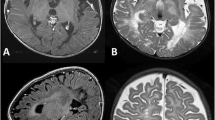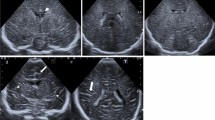Summary
A child afflicted with the hereditary cerebro-hepato-renal syndrome of Zellweger is reported. Important neurological features included: marked weakness and generalized hypotonia, recurrent seizures, and failure of development of visual, auditory or other sensory discriminations and “high-level” motor responses. Neuropathological study revealed a primary disturbance of development of the brain. The developmental disturbance consisted essentially of an incomplete migration of neuroblasts to form the cerebral cortical plate. The findings are discussed in relation to other types of cerebral dysgenesis. It is postulated that the precise disorder of neuronal migration in this disease delineates a specific step, probably mediated by a single protein, in the formation of the cerebral cortex. An additional finding, less certain of interpretation, is a widespread, diffuse degeneration of medullated nerve fibers in the cerebral white matter with phagocytosis of sudanophilic material by histiocytes and microglial cells.
Similar content being viewed by others
References
Angevine, J. B., Sidman, R. L.: Autoradiographic study of cell migration during histogenesis of cerebral cortex in the mouse. Nature (Lond.)192, 766–768 (1961).
Banker, B. Q., Larroche, J. C.: Periventricular leukomalacia of infancy. Arch. Neurol. (Chic.)7, 386–410 (1962).
Berry, M., Rogers, A. W., Eayrs, J. R.: Pattern of cell migration during cortical histogenesis. Nature (Lond.)203, 591–594 (1964).
Bielschowsky, M.: Über die Oberflächengestaltung des Großhirnmantels bei Pachygyrie, Mikrogyrie und bei normaler Entwicklung. J. Psychol. Neurol. (Lpz.)30, 29–76 (1923).
—, Rose, M.: Über die Pathoarchitektonik der mikro-und pachygyren Rinde und Bezeichnungen zur Morphogenie normaler Rindengebiete. J. Psychol. Neurol. (Lpz.)38, 42–46 (1929).
Bowen, P., Lee, C., Zellweger, H., Lindenberg, R.: A familial syndrome of multiple congenital defects. Bull. Johns Hopk. Hosp.114, 402–414 (1964).
Brun, A.: The subpial granular layer of the fetal cerebral cortex in man. Acta path. microbiol. scand., Suppl.179, 3–98 (1965).
Crome, L.: Microgyria. J. Path. Bact.64, 479–495 (1952).
—: Pachygyria. J. Path. Bact.71, 335–352 (1956).
Daube, J. R., Chou, S. M.: Lissencephaly: two cases. Neurology (Minneap.)16, 179–191 (1966).
DeLong, G. R.: Histogenesis of fetal mouse isocortex and hippocampus in reaggregating cell cultures. Develop. Biol.22, 563–583 (1970).
—, Sidman, R. L.: Alignment defect of reaggregating cells in cultures of developing brains of reeler mutant mice. Develop. Biol.22, 584–600 (1970).
Dieker, H., Edwards, R. H., Zurhein, G., Chou, S. M., Hartman, H. A., Opitz, J. M.: The lissencephaly syndrome. Birth Defects: Orig. Article Series5, 53–64 (1969).
Druckman, R., Chao, D., Alvord, E.: A case of atonic cerebral diplegia with lissencephaly. Neurology (Minneap.)9, 806–814 (1959).
Essick, C. R.: The development of the nucleus pontis and the nucleus arcuatus in man. Amer. J. Anat.13, 25–54 (1912).
Foerster, O.: Der atonische astatische Typus der infantilen cerebralen Lähmung. Dtsch. Arch. Med.98, 216–244 (1910).
Fujita, S.: Analysis of neuron differentiation in the central nervous system by tritiated thymidine autoradiography. J. comp. Neurol.123, 311–327 (1964).
—: Quantitative analysis of cell proliferation and diffferentiation in the cortex of the postnatal mouse cerebellum. J. Cell Biol.32, 277–287 (1967).
Grcevic, N., Robert, F.: Verrucose dysplasia of the cerebral cortex. J. Neuropath. exp. Neurol.20, 399–411 (1961).
Greenfield, J. G., Wolfson, J. M.: Microcephalia Vera. A study of two brains illustrating the agyric form and the complex microgyric form. Arch. Neurol. Psychiat. (Chic.)33, 1296 to 1316 (1935).
Hanaway, J., Lee, S. I., Netsky, M. G.: Pachygyria: relation of findings to modern embryologic concepts. Neurology (Minneap.)18, 791–799 (1968).
His, W.: die Entwicklung des menschlichen Rautenhirns vom Ende des ersten bis zum Beginn des dritten Monats. Leipzig: Hirzel 1891.
Jan, J. E., Hardwick, D. F., Lowry, R. B., MvCormick, A. Q.: Cerebro-hepato-renal syndrome of Zellweger. Amer. J. Dis. Child.119, 274–277 (1970).
Miale, I. L., Sidman, R. L.: An autoradiographic analysis of histogenesis in the mouse cerebellum. Exp. Neurol.4, 277–296 (1961).
Mickel, H. S., Gilles, F. H.: Changes in glial cells during human telencephalic myelinogenesis. Brain93, 337–346 (1970).
Miller, J. Q.: Lissencephaly in 2 siblings. Neurology (Minneap.)13, 841–850 (1963).
Norman, R. M.: Pachygyria. In: W. Blackwood, W. H. McMenemey, A. Meyer, and R. M. Norman: Greenfield's Neuropathology, pp. 356–361. Baltimore: Williams and Wilkins 1967.
Opitz, J. M., Zurhein, G. M., Vitale, L., Shahidi, N. S., Howe, J. J., Chou, S. M., Shanklin, D. S., Sybers, H. D., Dood, A. R., Gerritsen, T.: The Zellweger syndrome (Cerebrohepato-renal syndrome). Birth Defects: Orig. Article Series5, 144–158 (1969).
Passarge, E., McAdams, A. J.: Cerebro-hepato-renal syndrome. J. Pediat.71, 691–702 (1967).
Poznanski, A. K., Nosanchuk, J. S., Baublis, J., Holt, J. F.: The cerebro-hepato-renal syndrome (CHRS). Amer. J. Roentgenol.109, 313–322 (1970).
Punnett, H. H., Kirkpatrick, J. A.: A syndrome of ocular abnormalities, calcification of cartilage and failure to thrive. J. Pediat.73, 602–606 (1968).
Rakic, P., Sidman, R. L.: Supravital DNA synthesis in the developing human and mouse brain. J. Neuropath. exp. Neurol.27, 246–276 (1968).
—, Yakovlev, P. I.: Development of the corpus callosum and cavum septi in man. J. comp. Neurol.132, 45–72 (1968).
Rebeiz, J. J., Wolf, P. A., Adams, R. D.: Dystopic cortical myelinogenesis (“Driftwood Cortex”). Acta neuropath. (Berl.)11, 237–252 (1968).
Rose, A. L., Lumbroso, C. T.: Neonatal Seizure States. A study of clinical, pathological and electroencephalographic features in 137 full-term babies with a long-term follow-up. Pediatrics45, 404–425 (1970).
Sidman, R. L., Angevine, J. B.: Autoradiographic analysis of time of origin of nuclear versus cortical components of mouse telencephalon. Anat. Rec.142, 326 (1962).
—, Miale, I. L., Feder, N.: Cell proliferation and migration in the primitive ependymal zone: an autoradiographic study of histogenesis in the nervous system. Exp. Neurol.1, 322–333 (1959).
Smith, D. W., Opitz, J. M., Inhorn, S. L.: A syndrome of multiple developmental defects including polycystic kidneys and intrahepatic biliary dysgenesis in 2 siblings. J. Pediat.67, 617–624 (1965).
Taber, E.: Histogenesis of brain stem neurons studied autoradiographically with thymidine-H3 in the mouse. Anat. Rec.145, 291 (1963).
Taber Pierce, E.: Histogenesis of the nuclei griseum pontis, corporis pontobulbaris and reticularis tegmenti pontis (Bechterew) in the mouse. J. comp. Neurol.126, 219–240 (1960).
Taylor, J. C., Zellweger, H., Hanson, J.: Addendum: A new case of the Zellweger syndrome. Birth Defects: Orig. Article Series5, 159–160 (1969).
Vitale, L., Oittz, J. M., Shahidi, N. T.: Congenital and familial iron overload. New Engl. J. Med.280, 642–645 (1969).
Yakovlev, P. I.: Pathoarchitectonic studies of cerebral malformations. III. Arrhinencephalies (holotelencephalies). J. Neuropath. exp. Neurol.28, 22–55 (1959).
—: Morphological criteria of growth and maturation of the nervous system in man. Res. Publ. Ass. nerv. ment. Dis.39, 3–46 (1962).
—, LeCours, R. L.: The myelogenetic cycles of regional maturation of the brain. In: A. Minkowski: Regional Development of the Brain in Early Life, pp. 3–70. Oxford: Blackwell 1967.
—, Wadsworth, R. C.: Schizencephalies. A study of the congenital clefts in the cerebral mantle. I. Clefts with fused lips. J. Neuropath. exp. Neurol.5, 116–130 (1946).
Author information
Authors and Affiliations
Rights and permissions
About this article
Cite this article
Volpe, J.J., Adams, R.D. Cerebro-hepato-renal syndrome of Zellweger: An inherited disorder of neuronal migration. Acta Neuropathol 20, 175–198 (1972). https://doi.org/10.1007/BF00686900
Received:
Issue Date:
DOI: https://doi.org/10.1007/BF00686900




